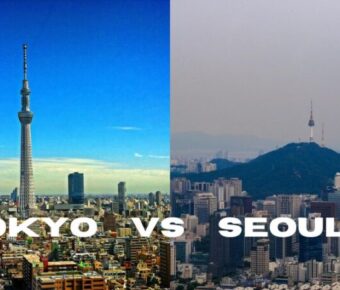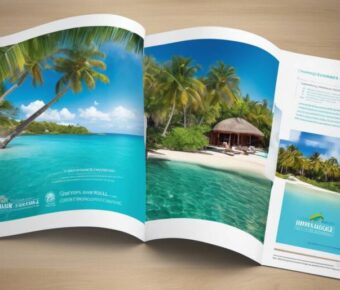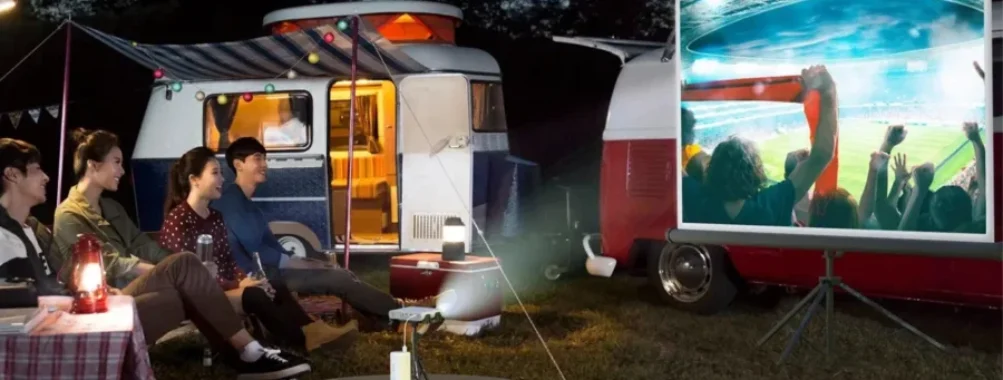
Portable Projector Screens for Travel: Top 5 Lightweight Options for On-the-Go Entertainment in 2025
Bringing a projector along can totally change your vacation vibe. Whether you’re planning hotel movie nights or need a sharp setup for business presentations, a good portable screen often makes or breaks the experience.
Manufacturers have designed portable projector screens specifically for travelers who want a quality viewing surface that won’t hog suitcase space.
You’ll find all sorts of options out there, from pull-up screens to inflatable ones. Some fold up into tiny cases, while others roll like maps—honestly, the variety can be overwhelming if you haven’t shopped for one before.
The best travel screens, in my opinion, strike a balance: They deliver a crisp image but don’t weigh you down or take forever to set up.
When you’re shopping, keep your eye on three things: weight, setup time, and screen material. If a screen weighs under 5 pounds, you’ll barely notice it in your luggage. Quick setup? That’s precious time saved for the actual fun stuff. And if you can get a screen with quality reflective fabric, your movies and presentations will look decent even if the lighting is less than ideal.
We took eight portable projector screens on a cross-country trip and put them through their paces to see which ones are actually worth packing.
Table of Contents
- Best Portable Projector Screens for Travel
- Mdbebbron Portable Projector Screen
- GT GETCO Portable Projector Screen
- Pyle Portable Screen
- ExcelImage Portable Projector Screen
- SKERELL Portable Projection Screen
- Pyle Portable Tripod Screen
- HOIN 80-inch Portable Projector Screen
- Pyle Portable Tripod Screen
- Buying Guide
- Material Quality
- Aspect Ratio Options
- Frequently Asked Questions
- What are the key features to look for in a high-quality portable projector screen for travelers?
- How do portable projector screens with stands compare to inflatable screens in terms of stability and ease of use for outdoor settings?
- Can you suggest creative solutions for improvised projector screens while on the go?
- What are the benefits and drawbacks of using foldable projector screens for frequent travelers?
- What size should a small portable projector screen be to balance portability and viewability?
- In terms of durability and image quality, how do the best-rated portable projector screens on the market perform?
- Book Your Dream Experience
- More Travel Guides
Best Portable Projector Screens for Travel
When you’re out exploring but still want to catch a movie or run a presentation, a solid travel projector screen is a must. These portable screens can be tiny in your bag, but deliver surprisingly big, clear images just about anywhere.
I’ve tested more models than I care to admit, and these are the ones that really nail that sweet spot between image quality, easy setup, and true portability.
Mdbebbron Portable Projector Screen
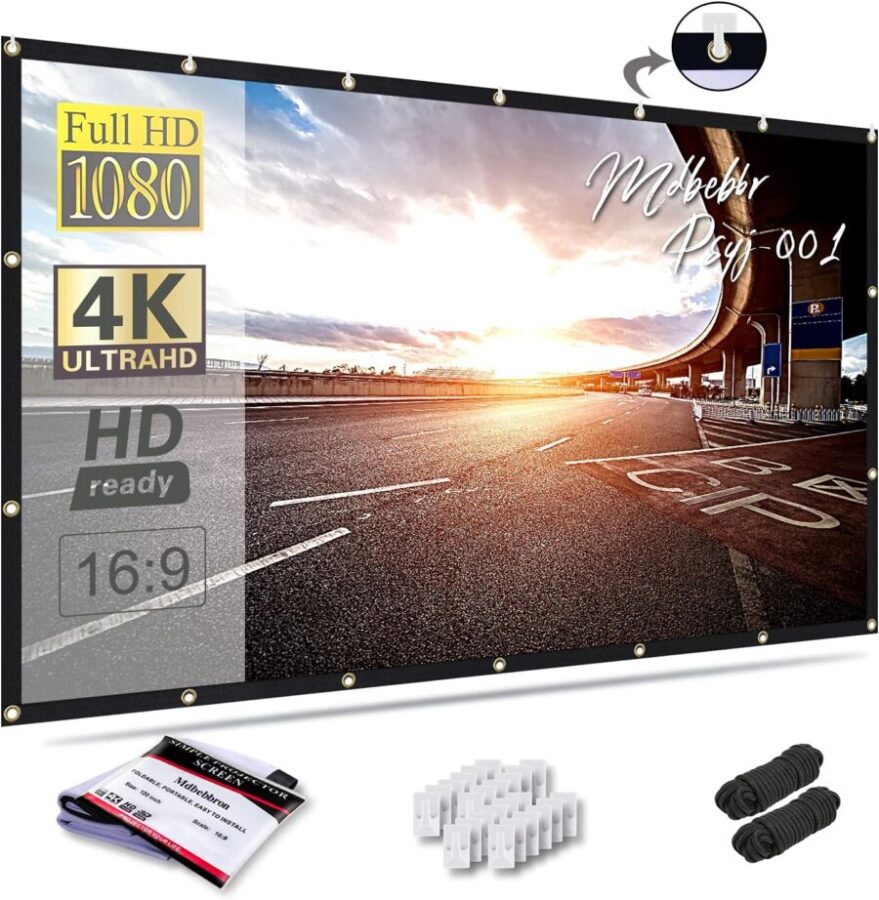
This 120-inch foldable screen is a fantastic pick for travelers who want big-screen entertainment but don’t want to deal with bulky gear.
Pros
- Packs up easily and takes almost no space
- Crisp image on both sides—pretty neat
- Setup is fast and doesn’t require any weird tools
Cons
- The included adhesive strips don’t hold up for long
- Needs a dark room for the best picture
- Slightly see-through if you’ve got a bright wall behind it
I took this on a family road trip, and honestly, I didn’t expect it to fold down so small. The whole 120-inch screen fit right in my backpack, and I still had room for snacks. The anti-crease claim isn’t just marketing—after days in my bag, it still looked smooth when I set it up.
Setting it up in the hotel was quick. The hooks worked for a night, but if you want to use it longer, I’d suggest bringing some command strips or sturdier hooks. The 16:9 format is spot-on for movies and streaming.
Image quality surprised me. Colors looked lively, and the white polyester fabric does a nice job, especially if you can dim the lights. I even tried projecting from both sides just to see, and it actually worked. At just 1.7 pounds, you’ll barely notice it in your suitcase. If you want to keep movie nights spontaneous but hate lugging gear, this Mdbebbron screen is a steal.
GT GETCO Portable Projector Screen
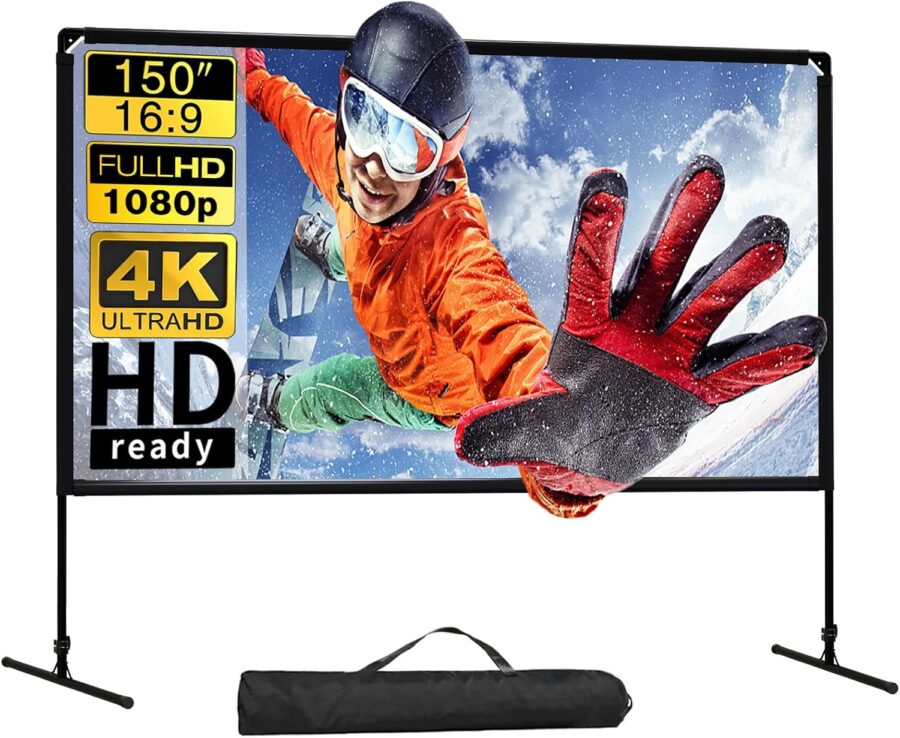
This 100-inch screen is a great pick for travelers who want a big-screen experience but don’t want to fuss with complicated gear.
Pros
- Setup is genuinely quick—under 5 minutes
- Surprisingly sturdy frame for how lightweight it is
- Carrying case is actually useful (for once)
Cons
- Acts like a sail if the wind picks up
- Stand feet could use proper ground stakes
- Screen material feels a bit thin
I brought this along on a camping trip and was honestly relieved by how fast it went from bag to ready-to-watch. The frame just snaps together, and the screen attaches with loops and velcro—no tools, no drama.
Picture quality is solid. The 16:9 format worked perfectly with my projector, and the wide 160° viewing angle meant everyone could see, even if they weren’t sitting dead center. The double-sided feature came in handy when we accidentally set up with the sun in the wrong spot.
Packing it down was easier than expected. At just under 11 pounds, carrying it from the car to the campsite wasn’t a hassle. The metal frame and fiberglass rods give it some backbone, but I’d definitely use the tie-downs if there’s any wind. For the price, it’s tough to find a better portable option for movie nights on the road.
Pyle Portable Screen
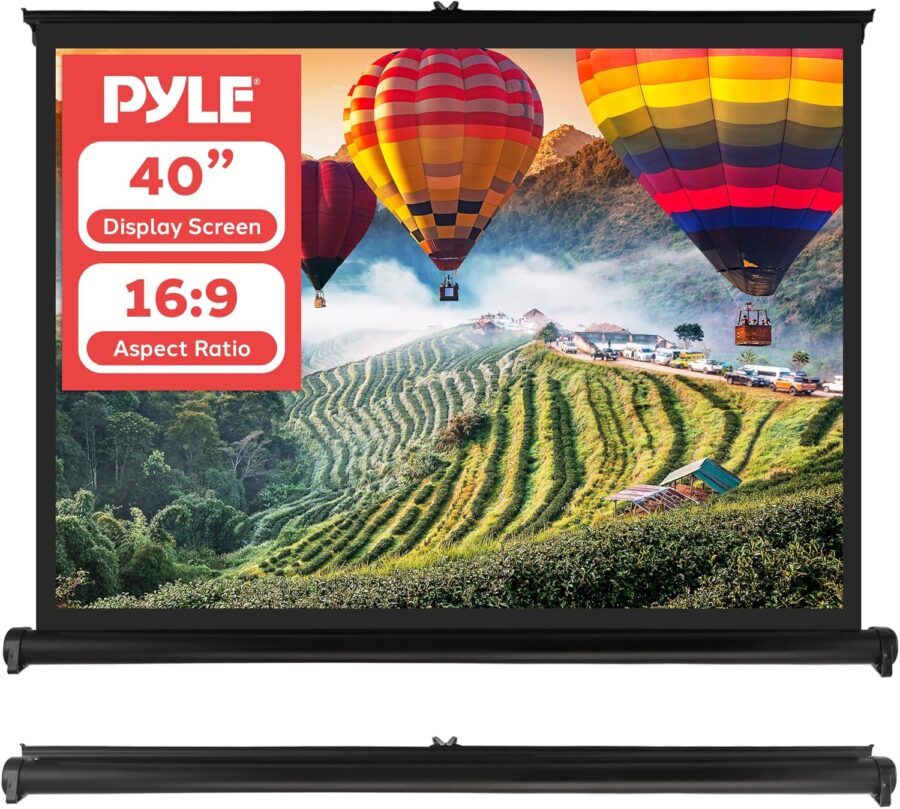
This 40-inch portable screen is a solid value for travelers who want something compact and hassle-free for business or movie nights.
Pros
- Super lightweight and easy to toss in a bag
- Sets up in seconds, no tools ever needed
- Matte fabric with black borders looks sharp
Cons
- Smaller viewing area than most
- Gets wobbly in breezes
- Stand limits where you can put it
I took this Pyle screen on a business trip and appreciated how little space it used in my bag. At just 3.74 pounds, it barely added any weight. The 40-inch size (actual viewing area is 32″ × 24″) was perfect for hotel rooms and tight conference spaces.
Setup is as easy as it gets. Just pop it on a table, pull the screen up, and lock it. The matte white fabric with black borders gave me surprisingly good picture quality in both dim hotel rooms and brighter offices. The flame-resistant material stayed flat—no annoying wrinkles.
The main issue is stability. When I tried it outside for a campsite movie night, even a mild breeze made it wobble. You’ll want to prop it against something sturdy if you’re outdoors. The 40-inch size is best for small groups—if you’re planning a party, look elsewhere. But for solo travelers or business folks, this Pyle model is hard to beat for convenience.
ExcelImage Portable Projector Screen
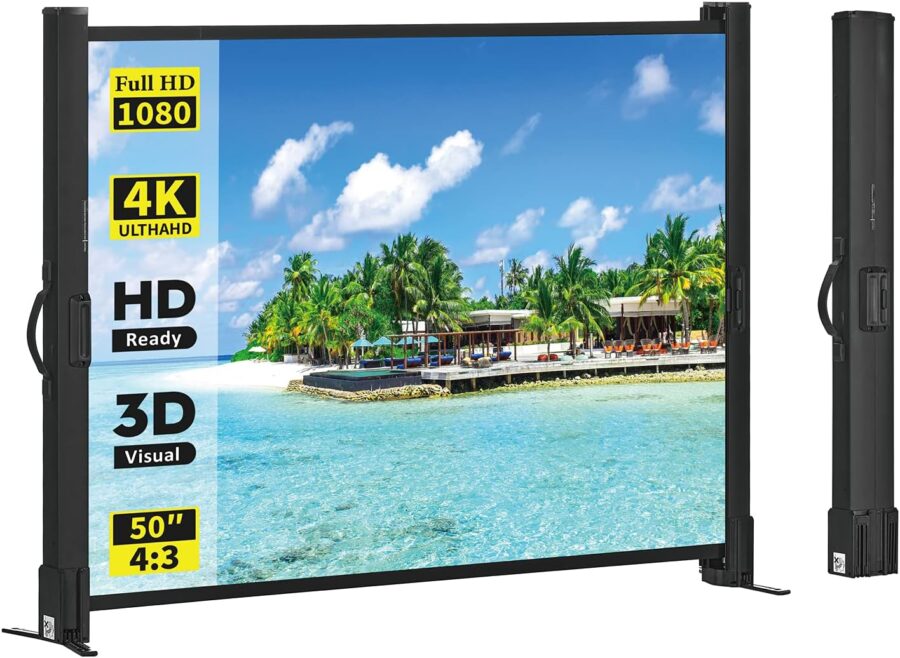
This lightweight 50-inch screen is a smart buy if you want a quick-setup display that doesn’t make you fumble with a million pieces.
Pros
- Weighs just 2.5 kg—ridiculously easy to carry
- Sets up in seconds with pull-out legs
- Aluminum frame keeps the screen nice and tight
Cons
- 50-inch size isn’t great for big crowds
- Stand legs feel fragile after a few uses
- Carrying case could use more padding
I took this ExcelImage screen on a work trip and loved how easy it was to haul around. It fit in my car trunk with my suitcase, and the handle made carrying it through the hotel a breeze. It’s about as heavy as a laptop, which is wild for a full projection setup.
Setup is a no-brainer—just pull out the legs and lock them. No messing with poles or loose fabric while your audience stares. I had it ready in under a minute, which is a lifesaver when you’re in a rush. The screen stayed flat, no wrinkles.
It uses a 4:3 aspect ratio, which is fine for business slides but not ideal for movies. For an impromptu movie night, the picture was bright and clear, and the wide viewing angle meant everyone could see. If you want something that works for both work and play, this screen is a practical pick.
SKERELL Portable Projection Screen
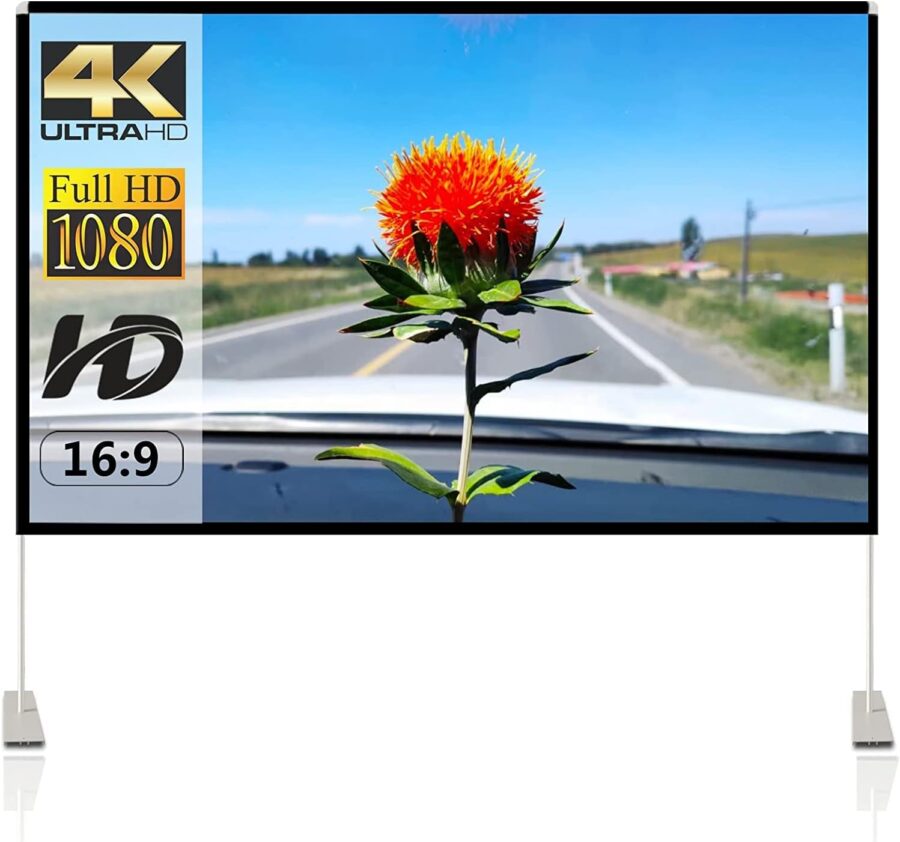
This 120-inch screen is a total game-changer for travelers who want a giant screen but don’t want to mess with complicated assembly.
Pros
- Sets up in about 5 minutes—no tools, no stress
- Only 6 lbs, plus an included carry bag
- Works for indoor and outdoor movie nights
Cons
- Base feet can get loose after several uses
- Frame needs careful handling
- Needs extra stability if it’s windy
I took this SKERELL screen camping with family, and I couldn’t believe how fast it went together. The aluminum frame just snaps in place, and I had it standing in five minutes flat. No screws, no confusion—just quick movie magic.
The screen material is impressive. The polyester spandex stretches evenly, and the image stayed sharp even when we watched from the sides. We set up our projector about 10 feet away, and everyone had a good view. You can use it for front or rear projection, which is handy if you’re improvising.
Traveling with it is easy. At just 6 pounds, it barely takes up space in the trunk, and the carry bag is actually useful. I even fit it behind the suitcases on a beach trip—no problem.
Stability is fine indoors, but if you’re outside, use the stakes. During a backyard movie night, a breeze kicked up, and I was glad I’d staked it down. Indoors, the weighted base keeps it steady on any flat floor.
Pyle Portable Tripod Screen
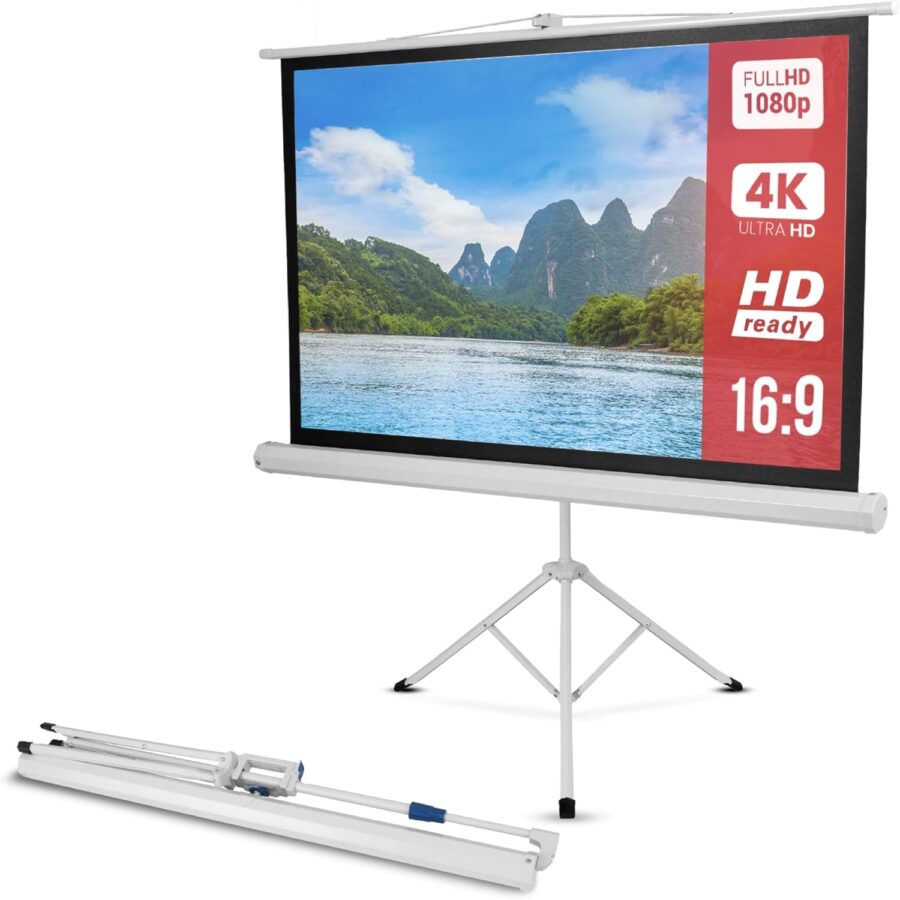
This 50-inch portable projector screen is a solid pick for travelers who want a viewing surface that sets up fast, without much hassle.
Pros
- Super quick setup thanks to the pull-up design
- Tripod base feels sturdy and doesn’t tip easily
- Matte fabric really does improve image quality
Cons
- No carrying case or strap included
- A bit heavier than you might expect—almost 10 pounds
- Can feel bulky in cramped travel situations
I dragged this Pyle screen along on a recent business trip. Honestly, the setup took less than a minute in my hotel room. The tripod legs pop open without drama, and the screen glides up from its aluminum case—no need to fight with wrinkles or mess with a finicky frame.
That matte white surface really shows its value. My presentation looked crisp, with decent color and barely any hotspotting. The black border gives off a more polished vibe, way better than just projecting onto a boring wall.
But let’s talk about the weight. At nearly 10 pounds, this isn’t something you’ll want to lug through multiple airports if you can avoid it. I kept wishing for a shoulder strap or a proper case, because the built-in handle isn’t quite enough; the screen tends to spin around when you walk, which gets old fast.
Surprisingly, setting up on uneven surfaces didn’t cause too many issues. The tripod legs adjust independently, which saved me when I needed to present outdoors on slightly bumpy ground. You can set it anywhere from 25 inches up to 48 inches high, so there’s some real flexibility depending on your setup.
HOIN 80-inch Portable Projector Screen
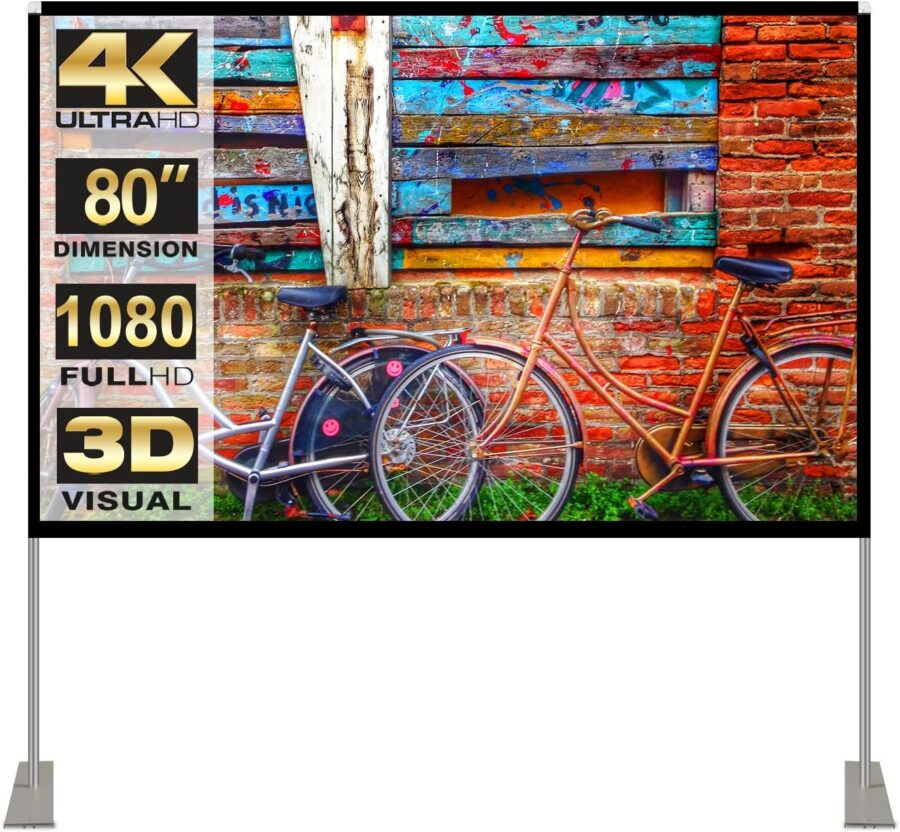
This portable projector screen brings a lot to the table for travelers who want something reliable and affordable.
Pros
- Sets up in minutes—no exaggeration
- Lightweight aluminum frame makes it easy to carry
- Works with both front and rear projection
Cons
- Not the best in windy weather
- Frame feels a little flimsy
- Needs flat ground for best performance
I took this screen out on a family camping trip and, honestly, I didn’t expect much for the price. But the aluminum frame clicked together in about five minutes, and the included bag made hauling it from the car to the campsite painless. It barely took up any room in my trunk, which is always a win.
The polyester screen material was better than I’d hoped. It doesn’t wrinkle much, so you get a nice, flat viewing surface—no annoying creases to distract you. I tried both front and rear projection, and with a 160° viewing angle, everyone in our group could see just fine, even from the sides.
If you’re planning to use this outdoors, bring some weights for the base. The first night, a light breeze had the screen wobbling more than I liked. I ended up grabbing a few rocks to keep the feet steady. At 80 inches, it’s a sweet spot—big enough for group movies but not so huge that it’s a pain to pack. For under $100, it’s become one of those travel gear staples that turns any spot into a pop-up theater.
Pyle Portable Tripod Screen
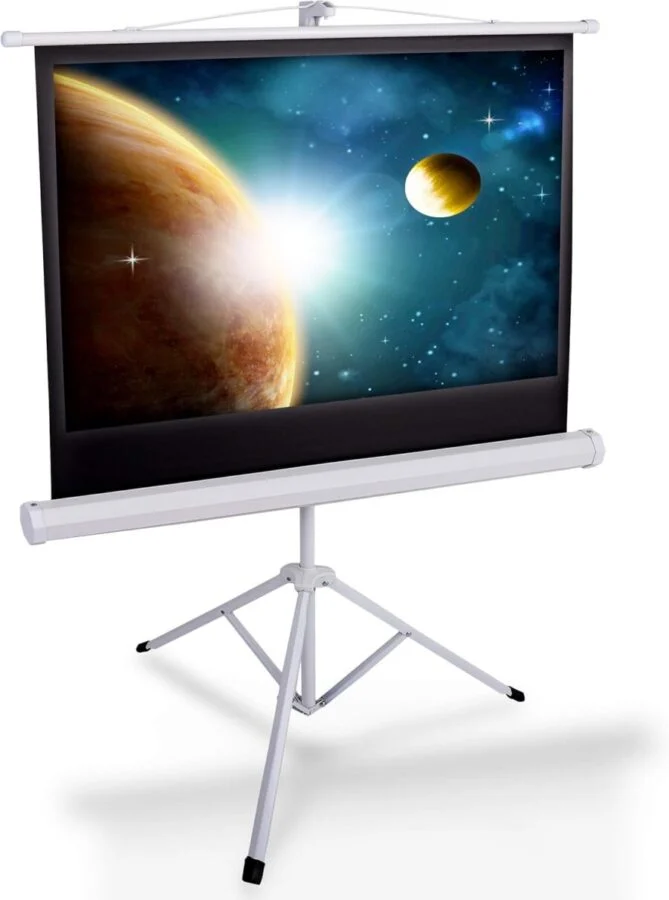
This lightweight 40-inch projector screen gets the job done for casual travelers who need a basic display that won’t break the bank.
Pros
- Sets up in seconds—no tools needed
- Light enough to carry between locations
- Adjustable height works for various spaces
Cons
- Smaller viewing area, so not great for big groups
- Still a bit bulky when folded, despite being “portable”
- Construction feels a little delicate for frequent flyers
I took this Pyle tripod screen on a recent work trip, and setup was a breeze. You unfold the tripod legs, pull up the screen, and lock it—done in under a minute. The white matte surface actually gave me clearer images than I expected, and the black border helped keep my slides focused.
Adjusting the height came in handy, especially in a cramped conference room. I could raise it for people in the back or lower it for a more close-up setting. The 4:3 aspect ratio is a little old-school, but for business slides, it worked just fine.
You’re not getting premium construction here. The aluminum housing and legs do the job, but they feel a bit fragile. It folds up smaller than a permanent screen, but still doesn’t fit in a carry-on without a struggle. For occasional travelers who need an affordable projection fix, this 40-inch Pyle is a practical compromise between portability and function.
Buying Guide

Picking the right portable projector screen for travel isn’t rocket science, but there are some details most folks overlook. After trying out more screens than I care to admit, I’ve figured out which features actually matter when you’re on the move.
Size matters—but not always how you’d expect. Think about where you’ll use your screen most. Hotel rooms? Outdoors? Conference spaces? The best size really depends on your viewing needs and how much you want to lug around.
Weight makes a big difference. If you’ll be carrying your screen often, look for models under 10 pounds. I once dragged a 15-pounder through three airports and, honestly, never again.
Material Quality
| Material Type | Best For | Drawbacks |
|---|---|---|
| Matte White | General use | Shows wrinkles easily |
| Glass-beaded | Brighter image | Narrower viewing angle |
| Gray | Better contrast | Less bright overall |
Setup time can make or break your travel experience. Tripod stands set up fast, pull-up designs save space, and frame models are sturdy but take up more room.
Aspect Ratio Options
Most portable screens come in 16:9 (widescreen) or 4:3 (classic) formats. Match this to your projector’s native output. I find 16:9 covers most needs—movies and presentations both look good.
Don’t overlook gain rating. That’s how reflective the screen is. Higher gain means a brighter image, but you lose viewing angle. For travel, a 1.0-1.3 gain is a sweet spot.
Frequently Asked Questions
Choosing the right portable projector screen can seriously upgrade your travel experiences. Here are some answers to questions I hear all the time from fellow travelers.
What are the key features to look for in a high-quality portable projector screen for travelers?
Start with weight and packed size. You want something under 10 pounds that’ll fit in your luggage or trunk.
Screen material matters more than you’d think. Go for wrinkle-resistant fabric with a gain between 1.0 and 1.3 if you can find it.
Setup time is huge. The best screens are ready in under three minutes, no tools or complicated steps required.
How do portable projector screens with stands compare to inflatable screens in terms of stability and ease of use for outdoor settings?
Stand-based screens win for stability, especially in a breeze. Adjustable legs and tension systems keep the screen taut.
Inflatable screens are ridiculously easy to set up—just plug in the blower and you’re set. You’ll need power, though.
In my experience, stand-based screens hold up better with repeated use. Inflatable ones are fun for the occasional beach movie, but they’re prone to punctures and tend to drift if it gets windy.
Can you suggest creative solutions for improvised projector screens while on the go?
A white sheet strung up between trees or poles works surprisingly well. Just pull it tight to avoid distracting wrinkles.
Light-colored hotel room walls can do in a pinch if they’re flat. I’ve even used the back of a pull-down window shade—wasn’t perfect, but it got the job done for a quick movie night.
If you return to the same vacation spot often, consider projection paint. Paint a small section of wall with it and you’ve got a permanent screen.
What are the benefits and drawbacks of using foldable projector screens for frequent travelers?
Foldable screens are super portable—often under 5 pounds and small enough for a carry-on. Business travelers who present a lot will appreciate that.
The downside? They crease. Even the good ones develop lines after a while, which can mess with your image, especially in bright scenes.
Setup is usually fast, but you’ll need a flat surface. Most foldable screens have to be hung or mounted, so you’re a bit limited on where you can use them.
What size should a small portable projector screen be to balance portability and viewability?
A 60 to 80-inch diagonal screen usually hits the sweet spot. It’s big enough for small groups but still easy to pack.
Think about how far you’ll sit from the screen. For hotel rooms or cozy outdoor setups, 60 inches is fine. For bigger gatherings, 80+ inches is better.
Aspect ratio matters too. Most modern content looks best on 16:9, but if you’re showing older stuff or business slides, 4:3 could make more sense.
In terms of durability and image quality, how do the best-rated portable projector screens on the market perform?
Elite Screens and Da-Lite really stand out when it comes to durability. I’ve seen these models hold up for three to five years of regular travel—honestly, not many brands can match that if you’re always on the go.
Image quality? That’s a whole other story. The material makes a massive difference. If you go with screens that have optical coatings, you’ll notice colors pop more and blacks look deeper, especially in rooms that aren’t pitch black. Cheaper screens just can’t compete here; they tend to look washed out the second you get some stray light in the room.
Now, a lot of high-end screens come with these nifty ambient light rejecting features. I’ve tested a few, and yeah, they’re not just marketing fluff. If you can’t always control the lighting—maybe you’re presenting in a hotel or at a friend’s place—these coatings actually help keep the image sharp and bright. Makes you wonder how you ever managed without them.

